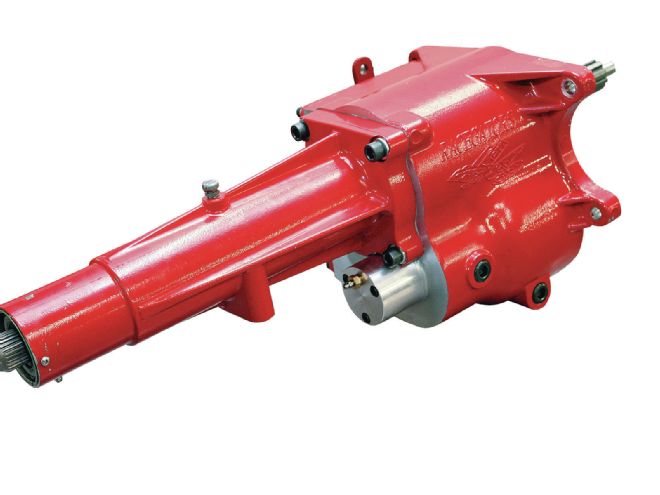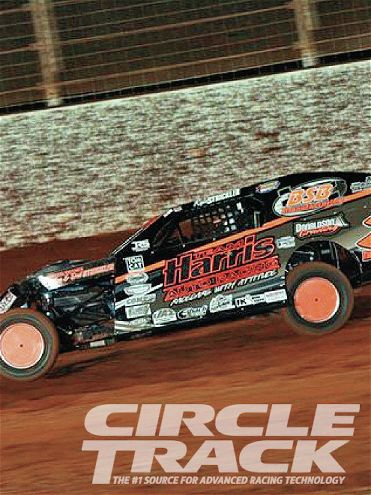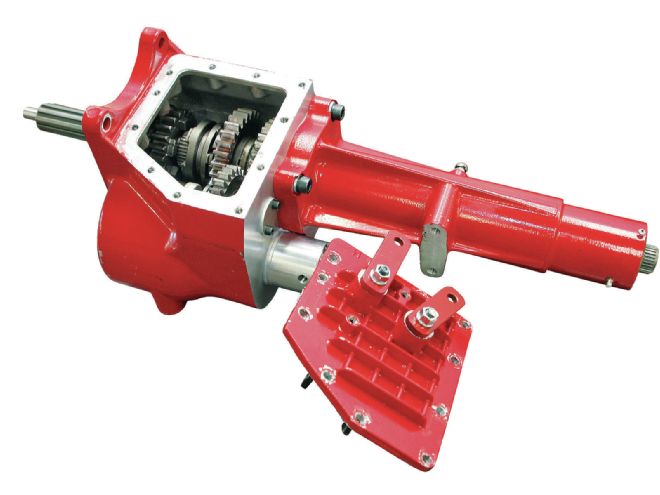
Lots of dirt track racing classes don't have a requirement in the rule book that an "OEM style" transmission must be used. This means instead of dragging an old Saginaw out of the junkyard or purchasing an aftermarket T10, you can use a transmission designed around the needs of a racer and not a design that must be modified to withstand the rigors of racing.
The result is a general transmission design that has been developed to take maximum advantage of the conditions most often found in dirt track racing. The typical dirt racing transmission is a two-speed unit designed for simplicity, toughness, and light weight. To minimize rotating weight, it actually does away with the traditional clutch and instead uses a very small clutch inside the transmission body. Limiting the transmission to two speeds also significantly reduces rotating mass. Low gear is typically used only to get the car out of the pits, and high gear is 1:1 direct drive for maximum efficiency when it comes to transferring the torque created by the engine to the rear wheels.
Honestly, there is nothing new about this style of transmission. It has been around for years and is produced by a number of different manufacturers. What is new, however, is a brand-new player on the scene that is manufacturing two-speed dirt track racing transmissions for significantly less than the current going rate. Most two-speed dirt transmissions currently sell for between $1,500 and $1,700, but this new unit by RaceGators Transmission is going for right at $1,200.
To be able to charge this much less means that this transmission is an import, but that's hardly unusual with racing components these days. But we're told that each transmission is checked by a gear specialist here in the States to ensure that the quality is up to standard. Currently, every transmission is being torn down and completely rebuilt, but RaceGators' specialist-located in Mooresville, North Carolina-told us that he has seen zero problems so far and that it is probably not necessary.
We also took notice because this new transmission has already proven itself in the only place that really matters: the racetrack. Dirt Modified driver Kyle Strickler became the first driver to take the RaceGators transmission to Victory Lane shortly after it was introduced when he won the NDRA Modz Dirt Modified race at The Dirt Track at Charlotte Motor Speedway in November 2011.
This new RaceGators transmission is aimed at Dirt Late Model, Dirt Modified and Sportsman classes. In fact, the uncoated version of this transmission has already been approved by the IMCA for competition. To find out if this new transmission might be a viable option for you in your next race car, we had one torn down and took a close look at each component. Truthfully, if you're familiar with this style of transmission, you won't be surprised by anything you see here. The RaceGator isn't trying to pack in the innovations. Instead, it's trying to make its name by supplying dirt track racers with a transmission with the performance and dependability they are used to at a significantly reduced cost.
From the Driver Seat
In the course of working on this story, we had the opportunity to speak with Dirt Modified driver Kyle Strickler, who recently won an NDRA Modified event at The Dirt Track at Charlotte Motor Speedway. We wanted to see if the less-costly transmission required more maintenance or a gentler driving style.
"No," he answered simply. "I didn't treat this transmission any differently than I did any of the others that I've raced, and it did exactly what I expected it to. From the driver's seat, you cannot tell what you have in the car, and obviously, it is capable of winning races. I haven't done anything special with the maintenance, and it hasn't given me any trouble." Strickler does recommend, however, that anyone using a two-speed dirt transmission for the first time make sure they understand how to properly operate one. "I've seen guys burn up the clutches before they even got out on the track because they didn't understand how to drive with this transmission," he says. "And that's understandable because they work just about opposite of the way every other transmission does."

Strickler has a great point because operating any transmission like this isn't exactly intuitive. Every two-speed transmission has four states of operation: Neutral, First gear, High gear, and Reverse. But the RaceGators transmission and all other transmissions like it don't use the clutch to disengage the gear.
Instead, putting the transmission into either First gear or Reverse and then pressing the clutch actually engages the gear. High gear is a 1:1 direct drive, so the clutch isn't used there.
So, for example, if you're exiting the pits to get onto the track, here's how the process would work. First, without placing your foot on the clutch, bump the gear selector into Reverse. Now press the clutch and give the car a little gas to back up. When you are ready to stop, release the clutch and apply the brakes if necessary.
Once the race car is stopped and with your foot still off the clutch, put the transmission into Low gear. Apply the clutch and enough throttle to get moving and drive until you get onto the track. With your foot still on the clutch, accelerate to around 3,000 rpm or so, release both the clutch and the gas, shift into High gear, apply the gas and get ready to go racing. If you need to stop, simply bump the gear selector out of gear and brake to a stop without engaging the clutch.
A transmission like this can handle gobs of horsepower reliably because the clutch isn't engaged at all during racing action. But the clutch's small size also makes it vulnerable to abuse. When driving in First or Reverse, always be careful not to feather the clutch. Instead, engage the clutch quickly and control your speed with the throttle. It can be a bit of an adjustment to get used to at first, but once you get the hang of it driving a transmission like this will become second nature.
RaceGators does offer a powder coatedcase and tailhousing option. This isn’t legal for IMCA classes (yet), but the powdercoating does make cleaning easier. Best of all, this upgrade only adds 30 bucks to the total bill.
